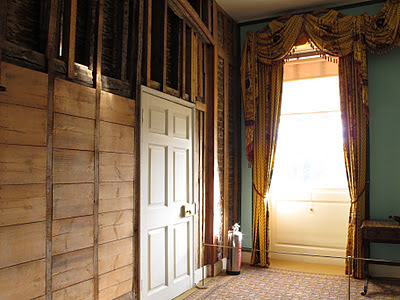 |
| Kew Palace |
This weekend, I had the fantastic opportunity to go on a
photographic course at Kew Palace, in Richmond. It was run by Historic Royal
Palaces and led by photographer Emily Harris. I love taking pictures of
architecture, as I hope my Facebook and Flickr pages show, but I was useless at
photographing indoors and this course was specifically for learning how to
capture historic interiors with a digital SLR camera. We were a select group of 7 and had the small but perfectly
formed “Palace” to ourselves as the place is officially closed to the public in
the autumn and winter months.
Kew Palace is one of HRP’s more recent restorations. I had
the privilege of visiting it half way through the restoration/conservation back
in 2006, so it was a pleasure to see the place in a more finished state. Not
that it is has been completely returned to resemble a royal residence. While
some rooms have been painstakingly decorated and furnished to show how the
house may have looked in about 1808, there are whole rooms untouched, with bare
floorboards and unfinished walls. These allow you to see how the walls were
constructed, layer by layer and give a fleeting look at the earlier, 17th
century fabric of the building behind.
Kew Palace has its origins in the 16th century,
with a Tudor undercroft as testament. It used to be called The Dutch House as
it is constructed in the unmistakeable Dutch style and inside is laid out over
3 floors with the undercroft below and servants living quarters in the attic.
The exterior structure we see today was built in the 17th
century, the home of a wealthy merchant and was then converted to be a home for
King George III his wife Queen Charlotte and 10 of their 15 children. Spending
my day there, I learned that the house was mainly for the children and the
Queen. George lived in an extension to the house, long since demolished. This
was because George III was the unfortunate monarch who suffered from the
disease “Porphyria” which manifested itself mainly in apparent raving madness.
But in his moments of sanity George and his wife were a
devoted loving couple, who enjoyed the relative simplicity and small scale
living at Kew with their children. Not that it was much fun for 3 of their
daughters who lived there; liking its remoteness and their lack of a social
life to being in a nunnery!
When one’s abiding passions are historic buildings and
photography there isn’t much about an historic interiors photography day at Kew
that I could fault. In fact there wasn’t. As a result, I like to think I can
now take a mean interior shot and that this’ll translate in the research I
prepare for my clients. But above all, my abiding memory will be having such
privileged access for a whole day in one of Historic Royal Palace’s most beautiful
and remarkable buildings.
Some of the photographs I took from the day will be posted
on the Historic Buildings Research Facebook page and on my Flickr page too.




